2012 VOLKSWAGEN GOLF PLUS warning light
[x] Cancel search: warning lightPage 47 of 541
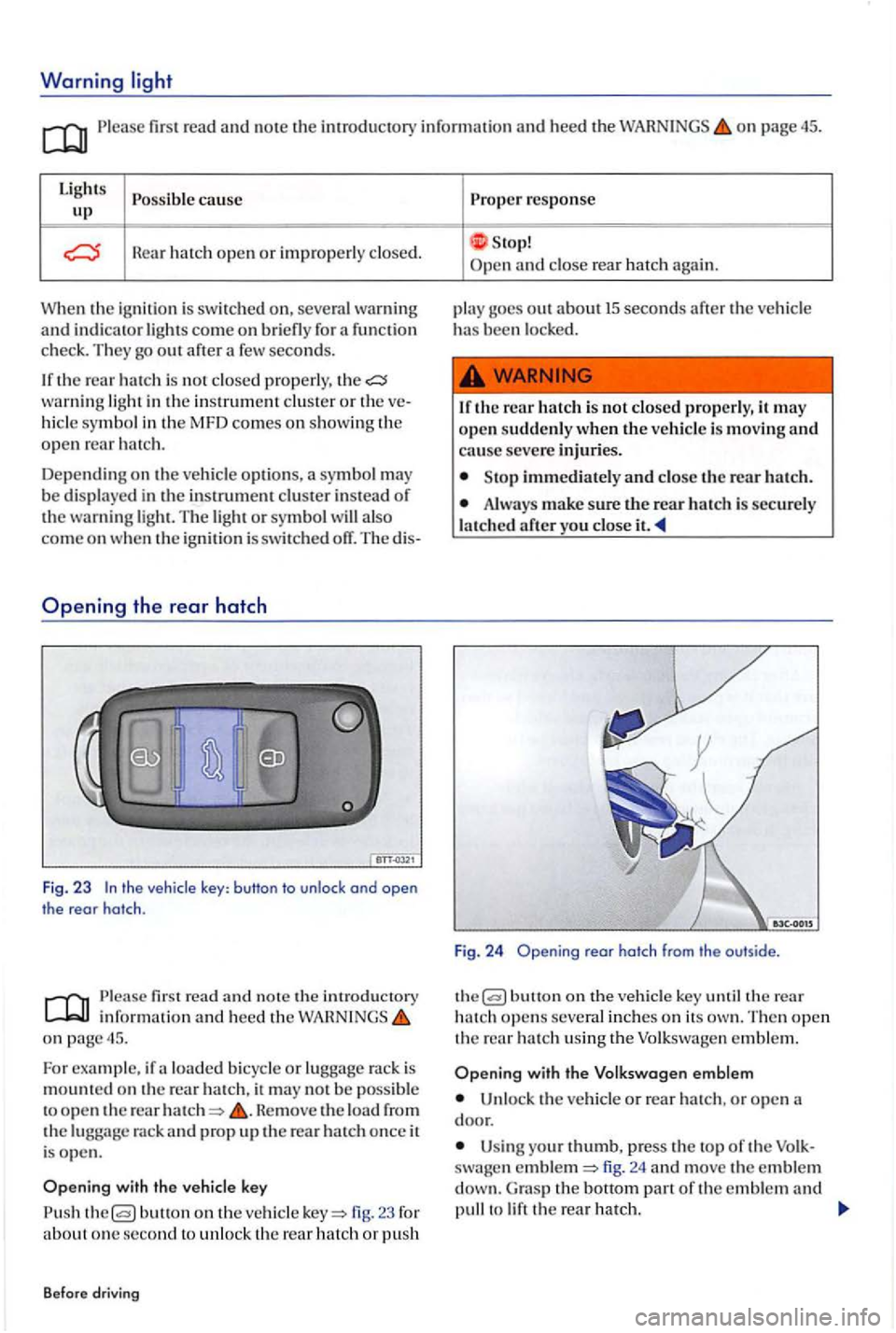
Warning
Please fir st r ead and note th e introductory in rormatio n and heed the o n page 45.
Lights
Possible cause
u p
the ignition is sw itch ed on, several warning and indica to r ligh ts come o n brierly ror a ru nctio n
c h ec k. They go out a
the rear h a tc h is not clo se d prope rly . wa rnin g light in the i nstrumen t clu ste r o r the hicl e symbol in th e MFD comes o n showin g the ope n r ear hat ch .
D ep en d in g o n the ve hi
cle opti ons, a symbol m ay
b e di splayed in th e in strument clu ster in ste ad or
t h e warnin g lig h t. The ligh t o r symbol
the vehicle key: button to unlock ond open
the rear hatch .
first read a nd n ote th e introducto ry inrorm atio n and heed t he o n page 45.
Fo r example, ir a lo ad ed b icy cle or lu gg age rac k is
m oun te d on the rear ha tc h , it m ay no t b e poss ible
t o o pe n th e rear He move the load rrom the rack and prop u p the rear ha tc h once it
i s ope n .
butto n on th e ve hicle 23 ror about o ne se cond to unl o ck th e re ar hatch or p ush
B efore dr
iving
Prope r response
S top! and close rea r hatc h again.
p la y goes o
ut ab o ut 15 seconds arte r the ve hicl e has been l ocke d.
1 r th e r
ear hatch i s not closed p ro perly, it m ay
o pe n sudde nly w hen the vehicle is movin g and cause seve re injuri es .
Sto p immedi ately and close t h e rear h atc h .
Alwa ys make sure the rear h atc h is sec u re ly
l a tc h ed
butt o n on the ve hicl e key th e rear hatch open s several in ch e s o n its The n open th e rear h a tc h usin g th e Volkswa gen e m ble m .
with the V olk swagen emblem
Un loc k th e ve h icl e or rear hatch , o r o pen
U sin g your thumb, p ress the to p or th e swa gen fig. 24 and move the e mble m G ra s p the bott o m part or th e e mble m and to
Page 59 of 541
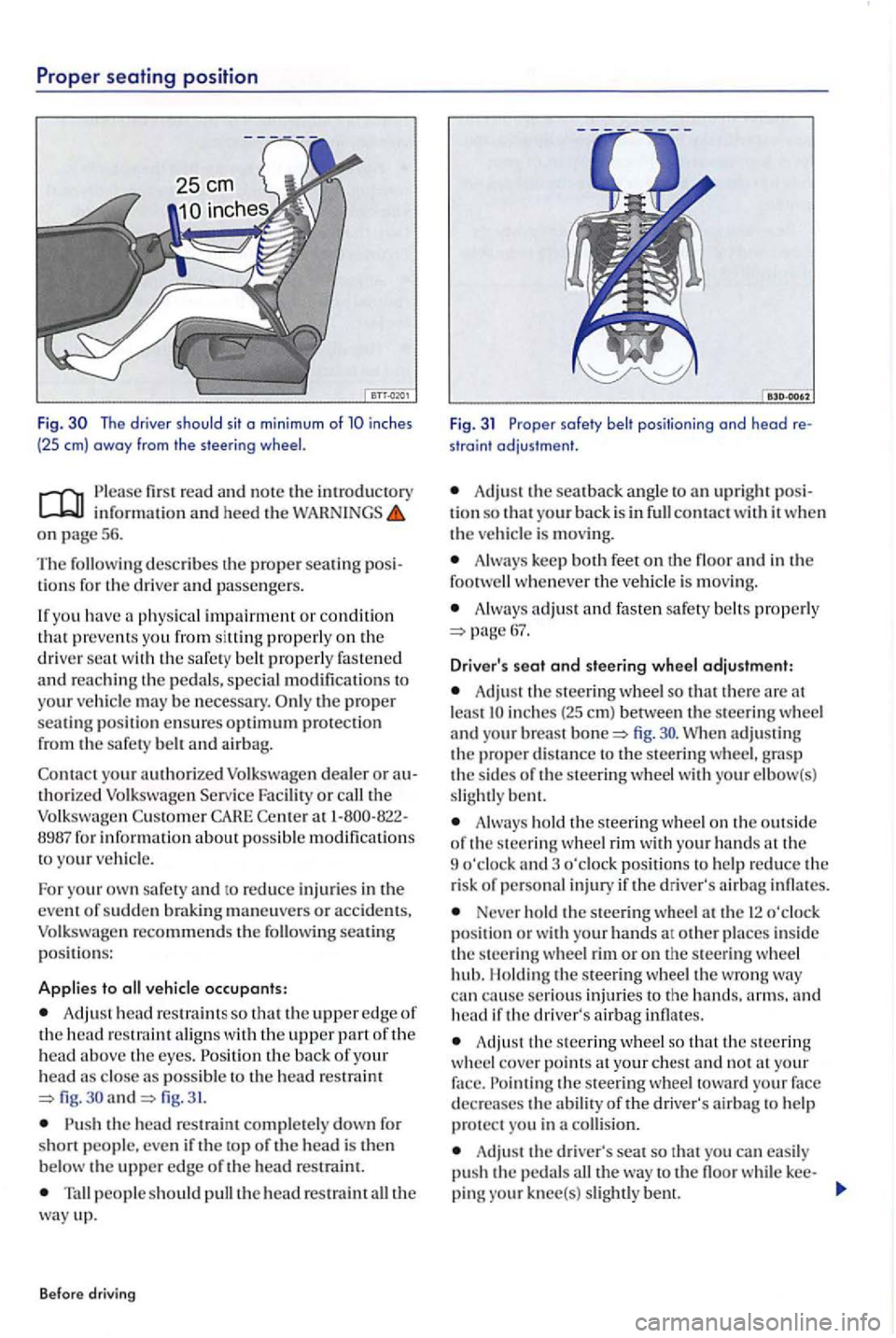
Prope r sea ting posit ion
Fig. The driver should sit o min imum of inches
(25 em) away from the steering
first read and note the introductory information an d heed the WARNINGS on page 5 6.
Th e
describes th e proper sea tin g lio ns for the driver and passengers .
If yo u hav e
physical impairment or condition that preve nts you from siltin g properly on the driver wit h the safe ty belt properly fastened and re a ching th e pedals, special modificatio ns to
your ve hicle may be necessary. p roper seating positi on ensures optimum protection from the safety belt and airbag.
Con t
act yo ur authorized Volkswagen dealer o r authorized Volk swage n Serv ice Facility or the Volkswagen Custo m er CAHE Cente r 1-800-822-
8987 fo r informati on about poss ible modification s
t o your ve hicl e.
F o r yo u r
own safety and to reduce inj urie s in the
event of sudde n brakin g maneuve rs or accid ents, Volkswagen recommends the seating p o siti ons:
Applies to vehicle occupants:
Adj ust head re straint s so that the upper edge of the head restraint aligns with the upper part of the head above th e eyes . the ba ck of your head close as poss ible fig. and fig. 31.
the head re straint completely down fo r
short people. eve n if the top of th e head is the n
b elow the uppe r edge o f the head re strai nt.
people s ho uld pull the head restraint the way up.
Before driving
Fig. 31 Proper safety belt positioning ond head re
straint adjustment.
Adjust the sea t back ang le to upri ght posi
tion so that your back is in conta ct w ith it w he n the vehicle is moving.
Alw ays keep both feet on th e floor a nd in the
foot whenever the vehicl e is mov in g.
A lway s adjust a nd fasten safety belt s pro perly
A dju st the steering wheel so that the re are lea st fig .
Always ho ld th e s teering wheel o n the out sid e
o f th e s teerin g wheel rim with your hands the
9 o'cloc k and 3 o'cloc k pos ition s to help re duce the
r is k of personal injury if the driver' s airb ag infl ates.
Never ho ld the steering wheel a t th e 12 o'clock position or w ith your hands at ot her places in side the steerin g wheel rim or o n the steerin g whee l
hub. l lo ldin g the steerin g w hee l the wro ng can cause se rious injurie s to the arms. and head if the driver's airbag infl ates.
Adju st the s teerin g wheel so that the s teerin g
w heel cove r points the ste erin g wh ee l toward your face
d ecrea ses the abilit y of the driver's airba g to help protect you in a collision.
Adju st the driver's seat so that you can easily
pu sh the pedal s the way to th e floo r while kee-
pin g knee(s) slightl y bent.
Page 68 of 541

Safety
Introduction
this sec tion y o u'll find informatio n on th e lowing:
Warning light ................ .... .. , .. .. , . . . 68
F ro ntal collis ions and l ows of ph ys ics . . . . . . . . . . . . 69
Whot happens to passengers no t wearing a safety
b elt? . . . . . . . . . . . . . . . . . . . . . . . . . . . . . . . . . . . . . . .
. . . . . . . . . .
. . 7 5
Safety belt exte nder . . . . . . . . . . . . . . . . . . . . . . . . . . 7 6
Safety belt retractor , pre te nsio ner, load limiter . . . . 78
Serv ice and d isposal of belt prete nsioners . . . . . . . 78
th e co nditi on of all safe ry belt s re gul arly. If a
sa fe ty belt s h ows da m age to we bbin g, b in din gs,
r et rac tors or bu ckles, have the safe ty belt replaced
b y an auth orized Volkswagen deafer or an rized Volk swagen Service rized Volkswagen deale rs and authorize d sw age n Se rv ice Fa cilities
Adju stin g th e seatin g pos ition
A ir ba g page
safety and c hild page
erl y position ed safety belt increa ses th e risk of severe pe rsona l injury or death. S afety belt s
offer optimum protection only whe n they are
u sed pro perly.
Safety belt s are the singl e most effecti ve
m eans availabl e to reduce th e r is k of seriou s jury and dea th in automobil e accid ents. For
your protection and that of your passengers ,
hicl e is moving.
Sitting properly and safely
Every person in the vehicle must b e properly
seat ed on
for e the vehicl e starts to move, and must k eep the belt properl y fastened while riding in the hicle. This applie s to the drive r and all g ers, ev en when ju st dri ving around town.
Alwa ys secure children in the vehicl e with a
restraint s ys te m appropriate for their age,
weight and page
Never attac h the safety belt to the buckl e o f another seat. Attachin g the safety belt to the wrong buckle will reduce safe ty belt
Never le t any obje cts or liquids get into the
s a fety belt latch and pre v ent it from working
prop erly. Alway s keep the belts clean. Dirty belt s
m ay n ot work correctly and can impair the
Neve r remove a safety belt w hil e the ve hicl e
i s moving. Doing so will increas e your risk of being injured or kill ed.
Ne ve r strap more than one person, includin g
s mall child ren, into any single safety belt .
N eve r let children or ba bies ride sitting on your lap and never place
Several layers of heavy clothing may
Ne ver wea r belt s ove r rigid or breakabl e jects in or on your clothing, such as eye glas ses,
p ens, keys etc., as these may ca us e injury.
Never use comfort clips or device s that creat slack in tl1e shoulder belt. Howev e r, spe cial clips may be require d for the correct use of some
c hild restraint sy ste m s.
Always ke ep saf ety belt buckl es fre e of anything
that may prevent the buckle from la tchin g sec urely.
Safe ty belt s off er optimum protecti on only when th e scat b ack is upright and belts a rc correctl y position ed on th e body
66 67
Page 69 of 541
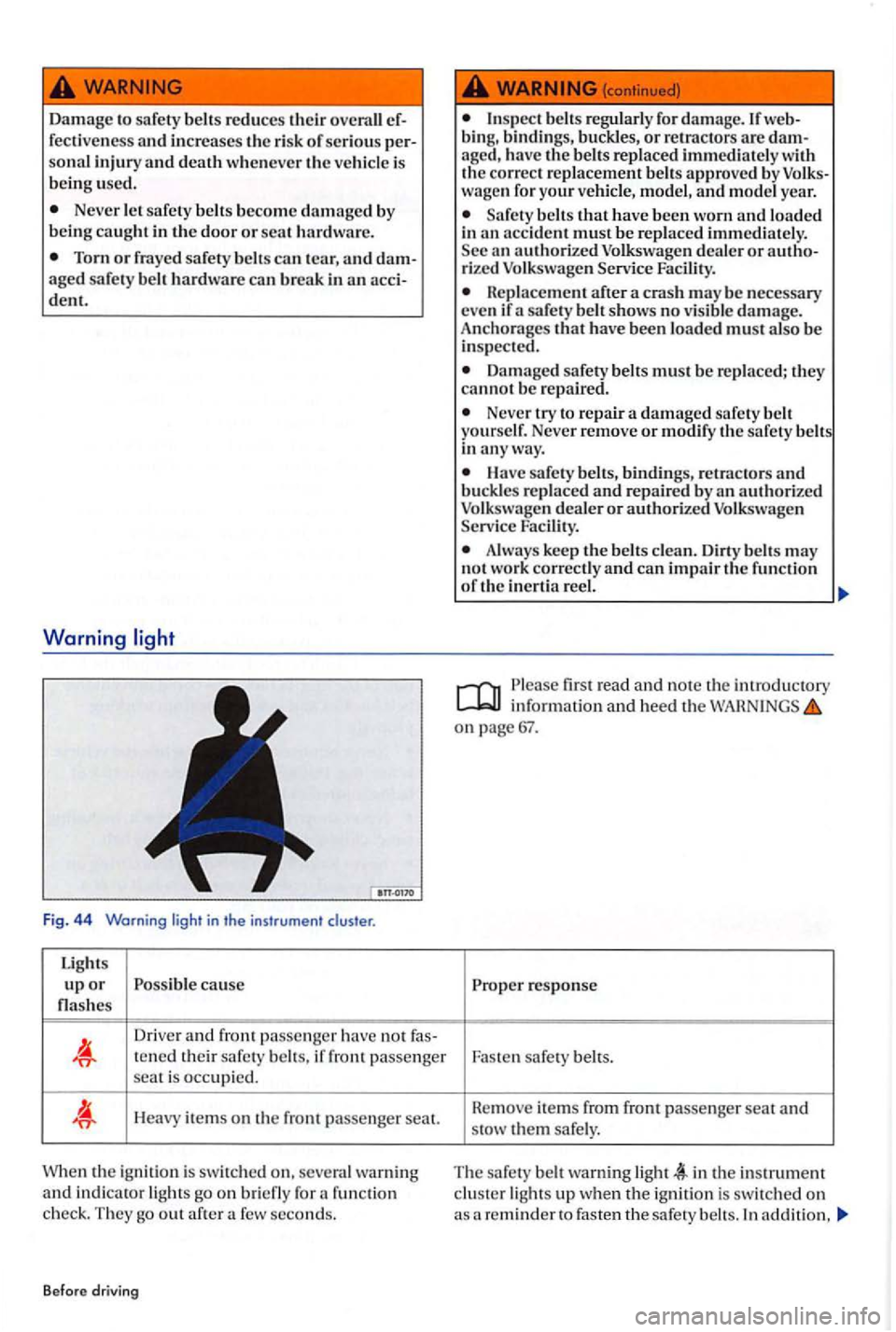
Damage to safety belt s reduces their ef
fectiven ess increase s the ris k of seriou s perinjury is
b ein g used.
Neve r safety belt s beco me damage d by
b ei ng caught in the door or seat hardware.
Torn or frayed safety te ar, and dam
aged safety hardware break in accident.
Warn ing
Fig. 44 Warning
Light s
u p o r cause
Driver and fron t pa sse nger have not fas-te n ed their safety if fron t passenger
sea t is occupied.
H eavy items on the front passenger seal.
the ignition is switched on. warning and in dica tor go on fun ction c he ck. They out after few seconds.
Before driving
for damage. If web
bin g, bindings, or re tra cto rs are damaged, have the approve d by wage n for your and year .
Safety that have bee n worn and in an accide nt must be
after a cras h may be nece ssary
eve n if safety sho ws no damage.
Anchorages that have been must
Damage d safety the y canno t b e re p air ed.
Neve r try to re pair a damage d sa fety Never remove or m odify th e safety
Have sa fety belts, binding s, retractor s and
or authorized Serv ice
k ee p the may
n ot work correct ly and ca n impair the function
o f th e in erti a
firs t rea d and note the introductory information and heed the on page 67.
Proper respo nse
Faste n safe ty
T he safety warning in the instrument
In add ition,
Page 70 of 541

you hear a warn ing chime. The warning light stop
when the driver and front passenger correctly fas ten their sa fety belts. If the safety belts have not been fastened when a speed of more than 15 mph is reached or if the safety be lts are unfastened
while the vehicle is moving , a warning chime for
up to seco nds. The belt warning light also
When the ignition is sw itched on, the warning
and of phy sic s
Fig. 4 5 A vehicle with passengers not wearing safety belts approaches a
on page 67.
The physical principles of a frontal
fig . 45.
which varies wit h vehicle speed and body weight.
Engineer s
The higher the speed of the ve hicle and the greater
the vehicle's weight. the more en ergy has to be in the cras h.
Vehicle speed i s th e most sig nificant factor. If the speed doubl es from to mph (25 to kmlh),
the energy increases 4 times!
The amount of as
the passengers' weight. The higher the speed an d
Sitting properly and solely
buckled up within about24 seconds after the
warn ing chim e has stopped, the warnin g chime sound again for about 6 seco nds, then stop for 24 seconds, and then rep eat this reminder sequence for a
Fig. 4 6 A vehicle with passengers not wearing safety
belts hits the
the greater the we ig ht, the more energy must be abso rbed in the crash.
Beca use the occupants of th e vehicle in the above
example a re not usi ng safety belts, they are not
kee p m oving at the same speed the vehicle was
mo vin g just before the crash, until somethin g
stops th em-here, the inside of the passenger com
partment. Because the occupants of the vehicle in
th e exa mpl e are not wearing safety belt s, th eir en
tire kine
tic energy be absorbed by impact with
the fig. 46.
Th e
same pri ncipl es app ly to p eople in a veh icle
th at is in a fron ta l
to mph to kmlh), the forces acting on th e bod y can reach one metri c ton kg o r lbs) or more. At grea te r speeds,
th ese forces are even hi ghe r.
68 69
Page 78 of 541
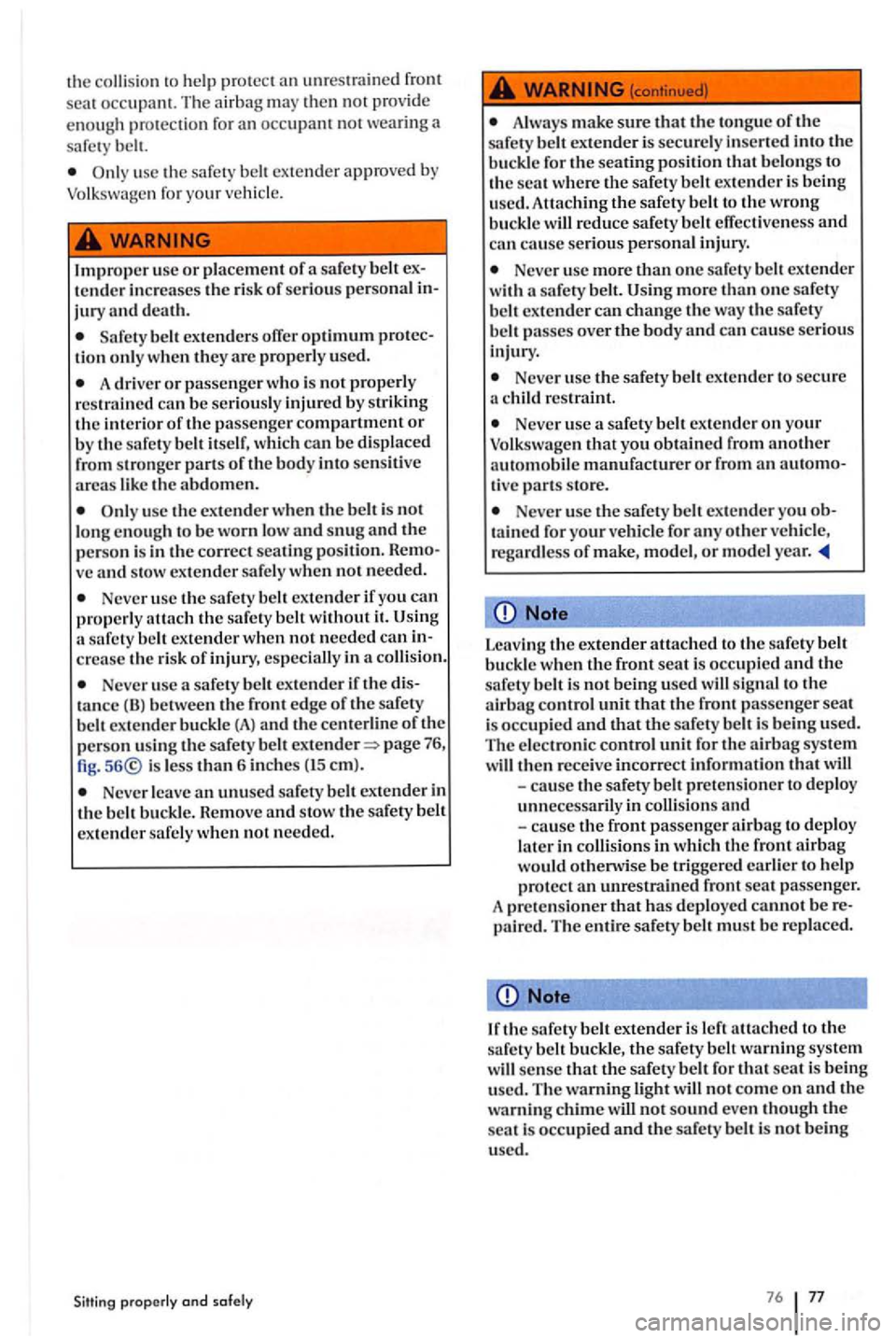
the colli sio n to help prot ect a n unrestrained front
sea t occ upa nt. The airba g m ay then not pro vide
e nou gh protection fo r an occ upant not wearin g a
s af ety be
lt.
u sc th e safety belt ex te nd er ap proved by Volkswag en for you r vehicl e.
Safety belt extenders offer optimum protec
tion onl y w hen they are prop erl y used.
A driver or passe nger wh o is not properl y
re strain ed ca n be seriou sly injured by strikin g
th e interi or o f t he passe nger compartment or by the s afety be lt itse lf, w hich can be displac ed fro m stron ger parts of the body int o se nsitiv e
area s lik e the abdomen.
usc the extender when the belt is not
lon g eno ugh t o be worn low and snug and th e person is in the correct sea ting po sition . R e m o
ve an d stow extender sa fe ly w hen no t needed.
Never usc the safety belt extender if you can prop erl y attach the safe ty be lt wit hout it. safety belt ex tender when not n eeded can crease the risk of inju ry, especiall y in a co llision.
Never use safety belt ex tender if the dis
tan ce (B ) between the front ed ge of the safe ty
b elt exte nd er buckle (A) and th e ce nterlin e of the perso n using the safety belt exte nde r= page 76, fig. 56 © is less than 6 in ches (15 em ).
Never leave an unused safe ty belt exte nder in the belt bu ckl e. Remo ve and stow the sa fety belt
ex te n d er safely wh en no t n eeded.
Sitti ng p roperly and safely
Always make sur e that the tongue of the
sa fety belt extender is securely inserted into the buckle for the seating position that belongs to
th e sca t where the safety belt extende r i s being
u se d. Attaching the safety belt to th e wrong
bu ckle will reduc e safety belt effec tive ness and can cause se rious perso nal injury.
Never usc more than one sa fe ty bel t extende r
w it h a safety belt. more than on e safety
b elt extender can change the way the sa fety
belt passes over the body a nd can cause seriou s
injury.
Never use the safety be lt ex tender to secure
a child restrai nt.
Never use a sa fety belt ex tend er on your
Neve r usc the safety belt ex tender you ob
t a in ed for your vehicl e for any other ve hicle,
regardless of m ake , model , or model year.
Note
Leaving the extender attached to the s afety be lt buck le when the front seat i s occ upied an d the safe ty belt is not being used w ill sig n al t o th e
a irbag control unit that the fron t passenger sea t
i s occupied and that the saf e ty be lt is be ing used. The electron ic contro l unit for th e a ir b ag system
will the n r eceive incorrect information that will
- ca use th e sa fety belt prete n sioner to deplo y unnecessarily in colli sion s and -ca use the front passe nger airb ag to dep loy
later in colli sion s in whic h th e front airba g
wo uld otherwise be triggered earlier to help
protec t a n unrestrain ed fron t sea t passe nger.
A pre te nsioner that has deployed cannot be p aired. The e ntire safety belt must be replaced.
! Note
If the safety belt extender is left atta ch ed to the
safe ty belt buckle, the safety belt warni ng sys te m
w ill sense that the sa fe ty be lt fo r th at seat is being
used . The w arning light will not come on and th e warning chime will not sound even though the
s cat is occ upie d and the safety belt is not b eing u sed.
76 77
Page 87 of 541
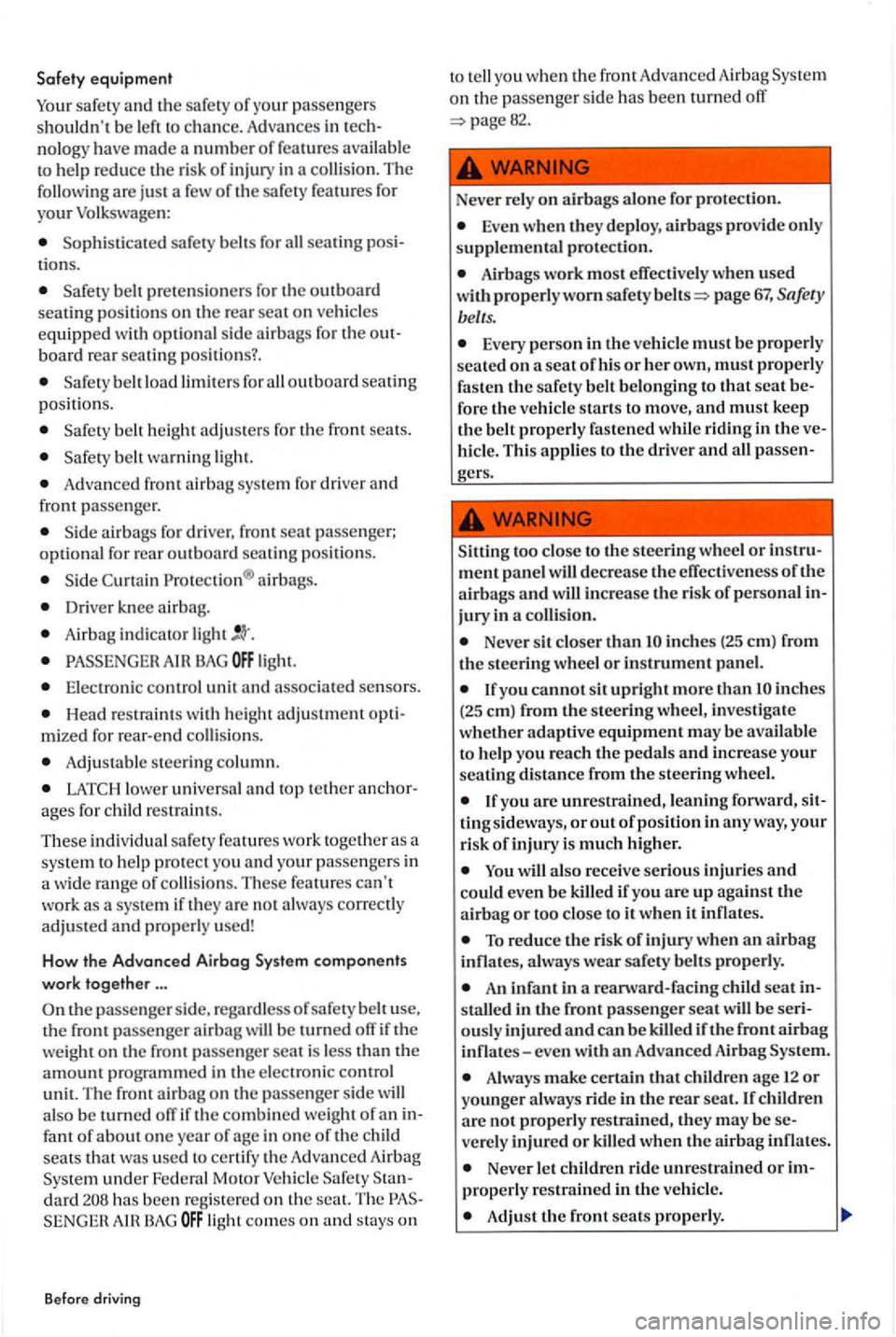
Safety equipment
safet y and the s afe ty of your p assenge rs shouldn 't be l eft to c han ce. Advances in tech
nolo gy have made a numb er of featur es available help reduce the ris k of injury in a collisio n. The follo wi ng are just a few o f th e sa fe ty features for your Volkswag en :
Soph is ticated safety belts for all seating posi
tions.
Safety belt pretensio ne rs for the outboard seatin g positi ons on the rea r seat o n ve hicl es equipped with optional side a irbags for the o ut
board rear seating positi ons?.
belt load limit ers fo r all outb oa rd seating
positions.
b elt h e ig ht adju ste rs for the front
belt warning light.
A dvanced front airba g sys tem for driver and fro nt passe nger.
airbag s.
Driver knee airbag .
Airbag indicator light
BAG light.
Ele ctronic cont rol unit and asso ciat ed senso rs.
Head res traint s w ith heig ht adju stment opt imized for rear -end collisio ns.
Adju stabl e stee rin g column.
lo w er univer sa l and top te th er an chor
age s for child restraint s.
These individual safety wo rk tog eth er as sys te m t o help pro tect yo u and your passenger s in w id e rang e of collisio ns. Th ese features can't
work as a syste m if they are no t a lwa ys correctly
adju ste d and prope rly used!
How the Advanced Airbag System components
work together ...
in
fan t of about one yea r o f ag e in one of th e c hild
seats u sed to certif y th e Adva nced Airb ag under Federa l Motor dard h as been regis te re d on th e seat. Th e AI sta ys on
Before driv ing
o n th e passenge r side has been turned off
Neve r rely on airbags alone for protec tion.
Even wh en they depl oy, airbags provide only
supplemental protection.
Airbag s work most effec tive ly when used with properly worn safe ty page 67, Safety
belt
s.
Every person in ve hicle must be prope rl y
se ated on a seal of his or he r own, must prope rl y
fasten the s afety belt belonging to that seat be
fore th e ve hicle start s to move, and must keep the belt properly fas tened w hil e riding in the ve
hicle. This applies to the dri ver and all passen-
too close to the steering wheel or instru
m ent panel will dec rease the effectiveness of th e
airbags and will increase the risk of personal in
jury in a coUision .
Never sit closer than inche s (25 em ) from the s teering whee l or instrument panel.
If yo u cannot sit upright more th an inch es (25 em) from the steering wheel, investigat e
whether adaptive equipment may be ava ilable
to help you reach the pedal s and increase your seating di stance from the steering wheel.
If you are unres trained , leaning fonvard, sit
tingsideway s, or out of position in anyway, your ris k of injury is m uch higher.
To reduce the risk of injury w hen an airbag always wear safety belt s properl y.
A n infant in a reanvard-facing child seat in
s talled in the front passe nge r seat w ill be seri
ously injured an d ca n b e killed if the front airbag
inflates-even with an Advanced Airbag
Always make certai n that children age 12 or younger alway s ride in the re ar seat. If childre n
are not properl y re stra in ed, they may be se
ve rel y injured or killed when th e infl ates.
Never le t children ride unres trained or im properly re strain ed in th e ve hicl e.
Adjust the front seats properly.
Page 103 of 541
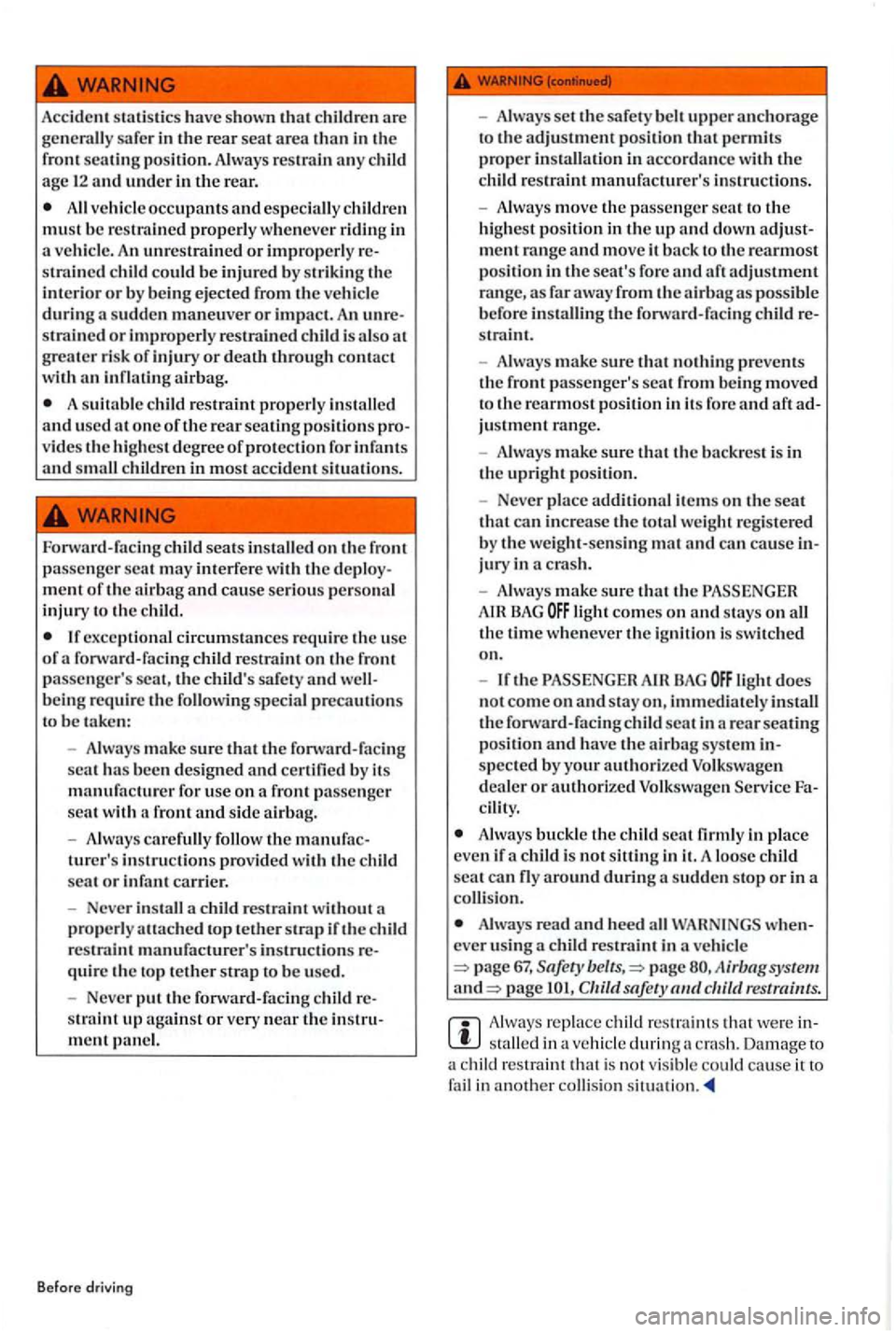
Accident stati sti cs have shown childr en are
generally safer in the rear seat area than in the front restrain any child age 12
All ve hicl e occupants and especially childr en must be restrai ned properly whenever ridin g in vehicle. An unrestrained or improperly strained child could be injured by striking the
interior o r by being ejected from the vehicle during sudden maneuver or impact. An strained or improp erly restrained child is at
airbag.
suitab le child rest raint properl y install ed and used
Forward-facing child seals installed on the front passenge r seat may interfere with the ment of th e a irbag and cause serious personal injury th e c hild .
exceptional circumstances require the u se of fonvard-fac ing child restraint on the front
passenger's seat, the child's safety and being requir e th e following special preca utions to be taken:
- Always
make sure that the fonvard-faci ng seal has bee n designed and certifi ed by its
m anufacturer for use on
ch ild res traint without top tether strap if the child
restraint manufacturer's instructions quire the top tether strap to be u sed.
- Never
putt he fonva rd-facing chil d
ment panel.
Before driving
-Always set the safety bell upper anchorage to the adjustmelll position permits
p roper
in the up and down
position in the seat's fore and aft adjustment range, as far away from the airbag as possib le
before installin g the fonvard -facing child s traint .
- Always
make sure that nothing prevents t h e fro nt passeng er' s scat fr o m being moved
justment range .
- Always
make sure that the backr est is in
th e upri ght position.
- Never place ad dit ional it
ems on the seal
th at can in crease th e total weight registered
b y the weight-se nsing mal cause jury in a crash.
- Always
make sure
BAG light does
not come on and stay on, immediately install
t h e fonvard-facingchi ld seat in rear seating sys tem spected by your authorized dealer or auth ori ze d Se rvice
A lways buckle the child seal in place
even if loose child seat ca n around during a sudd en slop or in a
Always read and heed all WARNINGS ever using child res train t in ve hicl e 67, Safety page 80,Airbagsystem page safety
A lways replace child restraint s that were s talled in cras h. Damage to
a child res traint that is not visib le co uld cause it to fail in another collision situati on